To_do_list.2013.5
java中list.sort的用法
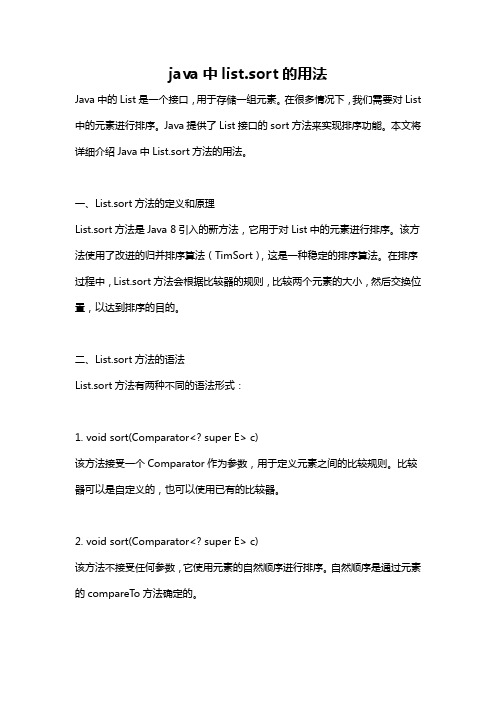
java中list.sort的用法Java中的List是一个接口,用于存储一组元素。
在很多情况下,我们需要对List 中的元素进行排序。
Java提供了List接口的sort方法来实现排序功能。
本文将详细介绍Java中List.sort方法的用法。
一、List.sort方法的定义和原理List.sort方法是Java 8引入的新方法,它用于对List中的元素进行排序。
该方法使用了改进的归并排序算法(TimSort),这是一种稳定的排序算法。
在排序过程中,List.sort方法会根据比较器的规则,比较两个元素的大小,然后交换位置,以达到排序的目的。
二、List.sort方法的语法List.sort方法有两种不同的语法形式:1. void sort(Comparator<? super E> c)该方法接受一个Comparator作为参数,用于定义元素之间的比较规则。
比较器可以是自定义的,也可以使用已有的比较器。
2. void sort(Comparator<? super E> c)该方法不接受任何参数,它使用元素的自然顺序进行排序。
自然顺序是通过元素的compareT o方法确定的。
三、使用自然顺序进行排序如果List中的元素实现了Comparable接口,并重写了compareT o方法,那么就可以使用List.sort方法进行排序。
以下是一个示例:List<String> list = new ArrayList<>();list.add("foo");list.add("bar");list.add("baz");list.add("qux");list.sort(null);System.out.println(list);输出结果为:[bar, baz, foo, qux]在上面的代码中,我们使用了List.sort方法对String类型的List进行排序。
大连东软信息学院Linux系统编程期末考试试题
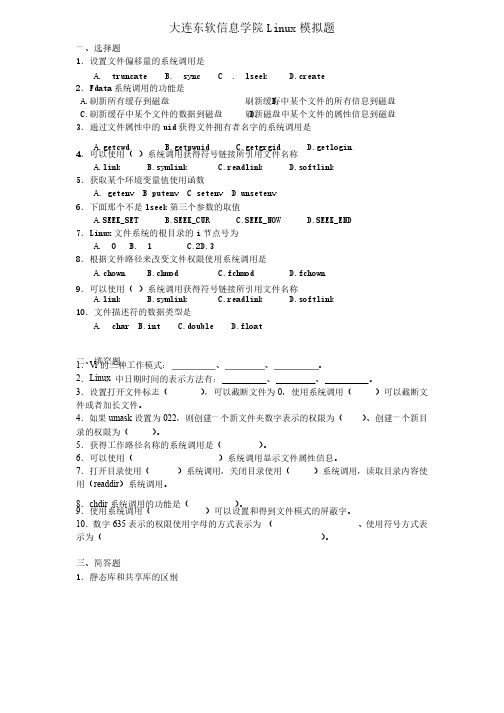
大连东软信息学院Linux 模拟题模拟题一、选择题一、选择题1.设置文件偏移量的系统调用是.设置文件偏移量的系统调用是A. truncate A. truncateB. sync B. sync B. sync C . lseek C . lseekD.create 2.Fdata 系统调用的功能是系统调用的功能是A.A.刷新所有缓存到磁盘刷新所有缓存到磁盘刷新所有缓存到磁盘B.刷新缓存中某个文件的所有信息到磁盘刷新缓存中某个文件的所有信息到磁盘C.C.刷新缓存中某个文件的数据到磁盘刷新缓存中某个文件的数据到磁盘刷新缓存中某个文件的数据到磁盘D. D.刷新磁盘中某个文件的属性信息到磁盘刷新磁盘中某个文件的属性信息到磁盘3.通过文件属性中的uid 获得文件拥有者名字的系统调用是获得文件拥有者名字的系统调用是A.getcwdB.getpwuid B.getpwuidC.getgrgid C.getgrgidD.getlogin D.getlogin 4.可以使用(.可以使用( )系统调用获得符号链接所引用文件名称)系统调用获得符号链接所引用文件名称A.link A.linkB.symlinkC.readlink C.readlinkD.softlink D.softlink5.获取某个环境变量值使用函数.获取某个环境变量值使用函数A .getenvB .putenvC .setenvD .unsetenv6.下面那个不是lseek 第三个参数的取值第三个参数的取值A.SEEK_SET A.SEEK_SETB.SEEK_CUR B.SEEK_CURC.SEEK_NOW C.SEEK_NOWD.SEEK_END7.Linux 文件系统的根目录的i 节点号为节点号为A. 0B. 1C.2D.38.根据文件路径来改变文件权限使用系统调用是.根据文件路径来改变文件权限使用系统调用是A.chownB.chmodC.fchmod C.fchmodD.fchown9.可以使用(.可以使用( )系统调用获得符号链接所引用文件名称)系统调用获得符号链接所引用文件名称A.link A.linkB.symlinkC.readlink C.readlinkD.softlink D.softlink1010.文件描述符的数据类型是.文件描述符的数据类型是.文件描述符的数据类型是A. charB.intC.doubleD.float二、填空题二、填空题 1.Vi 的三种工作模式:的三种工作模式:、 、 。
centos 内核list用法

centos 内核list用法CentOS内核list用法CentOS是一种开源的Linux发行版本,它的内核提供了一系列的list(列表)用法,用于高效地管理和操作数据。
在本文中,我们将介绍一些常用的CentOS内核list用法,并提供详细的讲解。
创建list1.使用[]符号创建一个空列表:my_list = []这将创建一个名为my_list的空列表。
2.使用list()函数创建一个空列表:my_list = list()这将创建一个名为my_list的空列表,与上述方法相同。
3.使用一系列元素创建一个列表:my_list = [1, 2, 3, 4]以上代码将创建一个名为my_list的列表,其中包含了数字1到4。
访问列表元素1.使用索引访问列表元素:my_list = [1, 2, 3, 4]print(my_list[0]) # 输出:1以上代码将输出列表my_list的第一个元素,即1。
2.使用负数索引访问列表元素:my_list = [1, 2, 3, 4]print(my_list[-1]) # 输出:4以上代码将输出列表my_list的最后一个元素,即4。
修改列表元素1.直接修改某个元素的值:my_list = [1, 2, 3, 4]my_list[0] = 5print(my_list) # 输出:[5, 2, 3, 4]以上代码将把列表my_list的第一个元素修改为5。
2.使用切片操作修改多个元素的值:my_list = [1, 2, 3, 4]my_list[1:3] = [5, 6, 7]print(my_list) # 输出:[1, 5, 6, 7, 4]以上代码将把列表my_list中索引为1至2的元素修改为5、6、7。
添加元素到列表1.使用append()方法在列表末尾添加一个元素:my_list = [1, 2, 3, 4]my_(5)print(my_list) # 输出:[1, 2, 3, 4, 5]以上代码将把元素5添加到列表my_list的末尾。
listprincs命令的用法

listprincs命令的用法一、介绍`l is tp ri nc s`命令是一个在文档管理中广泛使用的工具,它能够帮助我们列出指定的关键字,并提供相关的信息和操作。
本文将详细介绍`l is tp ri nc s`命令的用法和常见的应用场景。
二、基本用法`l is tp ri nc s`命令的基本语法如下:```l i st pr in cs[选项][关键字]```其中,关键字作为必选参数,用于指定我们想要搜索的内容。
我们可以通过一些选项来进一步控制搜索的范围和方式。
三、常见选项以下是`li st pr in cs`命令的常见选项及其说明:1.-a,--a l l该选项用于列出所有与关键字匹配的结果。
默认情况下,`l is tp ri nc s`命令只会显示与关键字最相关的结果。
2.-l,--l i m i t <n u m>通过这个选项,我们可以指定每页显示的结果数量。
`nu m`表示要显示的结果数量,默认为10。
可以根据实际需求进行调整。
3.-s,--s o r t <fi e l d>使用该选项可以对搜索结果进行排序。
`f i el d`表示排序的字段,可以是名称、日期、大小等。
默认情况下,搜索结果按照关键字的相关性排序。
4.-f,--f i l t er <t y p e>通过该选项可以对搜索结果进行过滤。
`t y pe`可以是文件类型、日期范围等。
例如,我们可以使用`-fp df`来仅显示P DF文档。
5.-h,--h e l p使用该选项可以获得命令的帮助信息,包括所有可用选项的说明和示例。
四、示例用法下面给出几个`l is tp r in cs`命令的示例用法,以帮助读者更好地理解其功能和用法。
1.列出所有与关键字匹配的结果```l i st pr in cs-a"关键字"```该命令将列出所有与关键字匹配的结果,不限制显示数量。
Native Instruments MASCHINE MIKRO MK3用户手册说明书
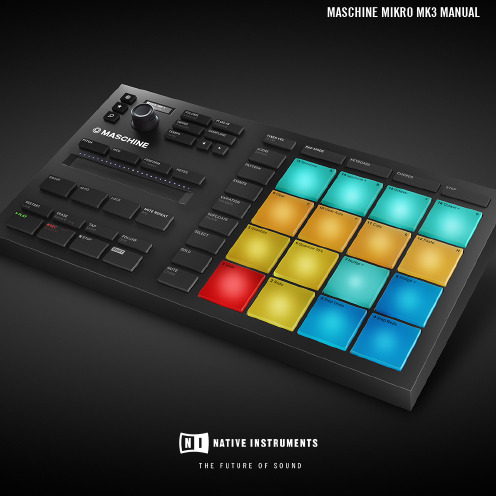
The information in this document is subject to change without notice and does not represent a commitment on the part of Native Instruments GmbH. The software described by this docu-ment is subject to a License Agreement and may not be copied to other media. No part of this publication may be copied, reproduced or otherwise transmitted or recorded, for any purpose, without prior written permission by Native Instruments GmbH, hereinafter referred to as Native Instruments.“Native Instruments”, “NI” and associated logos are (registered) trademarks of Native Instru-ments GmbH.ASIO, VST, HALion and Cubase are registered trademarks of Steinberg Media Technologies GmbH.All other product and company names are trademarks™ or registered® trademarks of their re-spective holders. Use of them does not imply any affiliation with or endorsement by them.Document authored by: David Gover and Nico Sidi.Software version: 2.8 (02/2019)Hardware version: MASCHINE MIKRO MK3Special thanks to the Beta Test Team, who were invaluable not just in tracking down bugs, but in making this a better product.NATIVE INSTRUMENTS GmbH Schlesische Str. 29-30D-10997 Berlin Germanywww.native-instruments.de NATIVE INSTRUMENTS North America, Inc. 6725 Sunset Boulevard5th FloorLos Angeles, CA 90028USANATIVE INSTRUMENTS K.K.YO Building 3FJingumae 6-7-15, Shibuya-ku, Tokyo 150-0001Japanwww.native-instruments.co.jp NATIVE INSTRUMENTS UK Limited 18 Phipp StreetLondon EC2A 4NUUKNATIVE INSTRUMENTS FRANCE SARL 113 Rue Saint-Maur75011 ParisFrance SHENZHEN NATIVE INSTRUMENTS COMPANY Limited 5F, Shenzhen Zimao Center111 Taizi Road, Nanshan District, Shenzhen, GuangdongChina© NATIVE INSTRUMENTS GmbH, 2019. All rights reserved.Table of Contents1Welcome to MASCHINE (23)1.1MASCHINE Documentation (24)1.2Document Conventions (25)1.3New Features in MASCHINE 2.8 (26)1.4New Features in MASCHINE 2.7.10 (28)1.5New Features in MASCHINE 2.7.8 (29)1.6New Features in MASCHINE 2.7.7 (29)1.7New Features in MASCHINE 2.7.4 (31)1.8New Features in MASCHINE 2.7.3 (33)2Quick Reference (35)2.1MASCHINE Project Overview (35)2.1.1Sound Content (35)2.1.2Arrangement (37)2.2MASCHINE Hardware Overview (40)2.2.1MASCHINE MIKRO Hardware Overview (40)2.2.1.1Browser Section (41)2.2.1.2Edit Section (42)2.2.1.3Performance Section (43)2.2.1.4Transport Section (45)2.2.1.5Pad Section (46)2.2.1.6Rear Panel (50)2.3MASCHINE Software Overview (51)2.3.1Header (52)2.3.2Browser (54)2.3.3Arranger (56)2.3.4Control Area (59)2.3.5Pattern Editor (60)3Basic Concepts (62)3.1Important Names and Concepts (62)3.2Adjusting the MASCHINE User Interface (65)3.2.1Adjusting the Size of the Interface (65)3.2.2Switching between Ideas View and Song View (66)3.2.3Showing/Hiding the Browser (67)3.2.4Showing/Hiding the Control Lane (67)3.3Common Operations (68)3.3.1Adjusting Volume, Swing, and Tempo (68)3.3.2Undo/Redo (71)3.3.3Focusing on a Group or a Sound (73)3.3.4Switching Between the Master, Group, and Sound Level (77)3.3.5Navigating Channel Properties, Plug-ins, and Parameter Pages in the Control Area.773.3.6Navigating the Software Using the Controller (82)3.3.7Using Two or More Hardware Controllers (82)3.3.8Loading a Recent Project from the Controller (84)3.4Native Kontrol Standard (85)3.5Stand-Alone and Plug-in Mode (86)3.5.1Differences between Stand-Alone and Plug-in Mode (86)3.5.2Switching Instances (88)3.6Preferences (88)3.6.1Preferences – General Page (89)3.6.2Preferences – Audio Page (93)3.6.3Preferences – MIDI Page (95)3.6.4Preferences – Default Page (97)3.6.5Preferences – Library Page (101)3.6.6Preferences – Plug-ins Page (109)3.6.7Preferences – Hardware Page (114)3.6.8Preferences – Colors Page (114)3.7Integrating MASCHINE into a MIDI Setup (117)3.7.1Connecting External MIDI Equipment (117)3.7.2Sync to External MIDI Clock (117)3.7.3Send MIDI Clock (118)3.7.4Using MIDI Mode (119)3.8Syncing MASCHINE using Ableton Link (120)3.8.1Connecting to a Network (121)3.8.2Joining and Leaving a Link Session (121)4Browser (123)4.1Browser Basics (123)4.1.1The MASCHINE Library (123)4.1.2Browsing the Library vs. Browsing Your Hard Disks (124)4.2Searching and Loading Files from the Library (125)4.2.1Overview of the Library Pane (125)4.2.2Selecting or Loading a Product and Selecting a Bank from the Browser (128)4.2.3Selecting a Product Category, a Product, a Bank, and a Sub-Bank (133)4.2.3.1Selecting a Product Category, a Product, a Bank, and a Sub-Bank on theController (137)4.2.4Selecting a File Type (137)4.2.5Choosing Between Factory and User Content (138)4.2.6Selecting Type and Character Tags (138)4.2.7Performing a Text Search (142)4.2.8Loading a File from the Result List (143)4.3Additional Browsing Tools (148)4.3.1Loading the Selected Files Automatically (148)4.3.2Auditioning Instrument Presets (149)4.3.3Auditioning Samples (150)4.3.4Loading Groups with Patterns (150)4.3.5Loading Groups with Routing (151)4.3.6Displaying File Information (151)4.4Using Favorites in the Browser (152)4.5Editing the Files’ Tags and Properties (155)4.5.1Attribute Editor Basics (155)4.5.2The Bank Page (157)4.5.3The Types and Characters Pages (157)4.5.4The Properties Page (160)4.6Loading and Importing Files from Your File System (161)4.6.1Overview of the FILES Pane (161)4.6.2Using Favorites (163)4.6.3Using the Location Bar (164)4.6.4Navigating to Recent Locations (165)4.6.5Using the Result List (166)4.6.6Importing Files to the MASCHINE Library (169)4.7Locating Missing Samples (171)4.8Using Quick Browse (173)5Managing Sounds, Groups, and Your Project (175)5.1Overview of the Sounds, Groups, and Master (175)5.1.1The Sound, Group, and Master Channels (176)5.1.2Similarities and Differences in Handling Sounds and Groups (177)5.1.3Selecting Multiple Sounds or Groups (178)5.2Managing Sounds (181)5.2.1Loading Sounds (183)5.2.2Pre-listening to Sounds (184)5.2.3Renaming Sound Slots (185)5.2.4Changing the Sound’s Color (186)5.2.5Saving Sounds (187)5.2.6Copying and Pasting Sounds (189)5.2.7Moving Sounds (192)5.2.8Resetting Sound Slots (193)5.3Managing Groups (194)5.3.1Creating Groups (196)5.3.2Loading Groups (197)5.3.3Renaming Groups (198)5.3.4Changing the Group’s Color (199)5.3.5Saving Groups (200)5.3.6Copying and Pasting Groups (202)5.3.7Reordering Groups (206)5.3.8Deleting Groups (207)5.4Exporting MASCHINE Objects and Audio (208)5.4.1Saving a Group with its Samples (208)5.4.2Saving a Project with its Samples (210)5.4.3Exporting Audio (212)5.5Importing Third-Party File Formats (218)5.5.1Loading REX Files into Sound Slots (218)5.5.2Importing MPC Programs to Groups (219)6Playing on the Controller (223)6.1Adjusting the Pads (223)6.1.1The Pad View in the Software (223)6.1.2Choosing a Pad Input Mode (225)6.1.3Adjusting the Base Key (226)6.2Adjusting the Key, Choke, and Link Parameters for Multiple Sounds (227)6.3Playing Tools (229)6.3.1Mute and Solo (229)6.3.2Choke All Notes (233)6.3.3Groove (233)6.3.4Level, Tempo, Tune, and Groove Shortcuts on Your Controller (235)6.3.5Tap Tempo (235)6.4Performance Features (236)6.4.1Overview of the Perform Features (236)6.4.2Selecting a Scale and Creating Chords (239)6.4.3Scale and Chord Parameters (240)6.4.4Creating Arpeggios and Repeated Notes (253)6.4.5Swing on Note Repeat / Arp Output (257)6.5Using Lock Snapshots (257)6.5.1Creating a Lock Snapshot (257)7Working with Plug-ins (259)7.1Plug-in Overview (259)7.1.1Plug-in Basics (259)7.1.2First Plug-in Slot of Sounds: Choosing the Sound’s Role (263)7.1.3Loading, Removing, and Replacing a Plug-in (264)7.1.4Adjusting the Plug-in Parameters (270)7.1.5Bypassing Plug-in Slots (270)7.1.6Using Side-Chain (272)7.1.7Moving Plug-ins (272)7.1.8Alternative: the Plug-in Strip (273)7.1.9Saving and Recalling Plug-in Presets (273)7.1.9.1Saving Plug-in Presets (274)7.1.9.2Recalling Plug-in Presets (275)7.1.9.3Removing a Default Plug-in Preset (276)7.2The Sampler Plug-in (277)7.2.1Page 1: Voice Settings / Engine (279)7.2.2Page 2: Pitch / Envelope (281)7.2.3Page 3: FX / Filter (283)7.2.4Page 4: Modulation (285)7.2.5Page 5: LFO (286)7.2.6Page 6: Velocity / Modwheel (288)7.3Using Native Instruments and External Plug-ins (289)7.3.1Opening/Closing Plug-in Windows (289)7.3.2Using the VST/AU Plug-in Parameters (292)7.3.3Setting Up Your Own Parameter Pages (293)7.3.4Using VST/AU Plug-in Presets (298)7.3.5Multiple-Output Plug-ins and Multitimbral Plug-ins (300)8Using the Audio Plug-in (302)8.1Loading a Loop into the Audio Plug-in (306)8.2Editing Audio in the Audio Plug-in (307)8.3Using Loop Mode (308)8.4Using Gate Mode (310)9Using the Drumsynths (312)9.1Drumsynths – General Handling (313)9.1.1Engines: Many Different Drums per Drumsynth (313)9.1.2Common Parameter Organization (313)9.1.3Shared Parameters (316)9.1.4Various Velocity Responses (316)9.1.5Pitch Range, Tuning, and MIDI Notes (316)9.2The Kicks (317)9.2.1Kick – Sub (319)9.2.2Kick – Tronic (321)9.2.3Kick – Dusty (324)9.2.4Kick – Grit (325)9.2.5Kick – Rasper (328)9.2.6Kick – Snappy (329)9.2.7Kick – Bold (331)9.2.8Kick – Maple (333)9.2.9Kick – Push (334)9.3The Snares (336)9.3.1Snare – Volt (338)9.3.2Snare – Bit (340)9.3.3Snare – Pow (342)9.3.4Snare – Sharp (343)9.3.5Snare – Airy (345)9.3.6Snare – Vintage (347)9.3.7Snare – Chrome (349)9.3.8Snare – Iron (351)9.3.9Snare – Clap (353)9.3.10Snare – Breaker (355)9.4The Hi-hats (357)9.4.1Hi-hat – Silver (358)9.4.2Hi-hat – Circuit (360)9.4.3Hi-hat – Memory (362)9.4.4Hi-hat – Hybrid (364)9.4.5Creating a Pattern with Closed and Open Hi-hats (366)9.5The Toms (367)9.5.1Tom – Tronic (369)9.5.2Tom – Fractal (371)9.5.3Tom – Floor (375)9.5.4Tom – High (377)9.6The Percussions (378)9.6.1Percussion – Fractal (380)9.6.2Percussion – Kettle (383)9.6.3Percussion – Shaker (385)9.7The Cymbals (389)9.7.1Cymbal – Crash (391)9.7.2Cymbal – Ride (393)10Using the Bass Synth (396)10.1Bass Synth – General Handling (397)10.1.1Parameter Organization (397)10.1.2Bass Synth Parameters (399)11Working with Patterns (401)11.1Pattern Basics (401)11.1.1Pattern Editor Overview (402)11.1.2Navigating the Event Area (404)11.1.3Following the Playback Position in the Pattern (406)11.1.4Jumping to Another Playback Position in the Pattern (407)11.1.5Group View and Keyboard View (408)11.1.6Adjusting the Arrange Grid and the Pattern Length (410)11.1.7Adjusting the Step Grid and the Nudge Grid (413)11.2Recording Patterns in Real Time (416)11.2.1Recording Your Patterns Live (417)11.2.2Using the Metronome (419)11.2.3Recording with Count-in (420)11.3Recording Patterns with the Step Sequencer (422)11.3.1Step Mode Basics (422)11.3.2Editing Events in Step Mode (424)11.4Editing Events (425)11.4.1Editing Events with the Mouse: an Overview (425)11.4.2Creating Events/Notes (428)11.4.3Selecting Events/Notes (429)11.4.4Editing Selected Events/Notes (431)11.4.5Deleting Events/Notes (434)11.4.6Cut, Copy, and Paste Events/Notes (436)11.4.7Quantizing Events/Notes (439)11.4.8Quantization While Playing (441)11.4.9Doubling a Pattern (442)11.4.10Adding Variation to Patterns (442)11.5Recording and Editing Modulation (443)11.5.1Which Parameters Are Modulatable? (444)11.5.2Recording Modulation (446)11.5.3Creating and Editing Modulation in the Control Lane (447)11.6Creating MIDI Tracks from Scratch in MASCHINE (452)11.7Managing Patterns (454)11.7.1The Pattern Manager and Pattern Mode (455)11.7.2Selecting Patterns and Pattern Banks (456)11.7.3Creating Patterns (459)11.7.4Deleting Patterns (460)11.7.5Creating and Deleting Pattern Banks (461)11.7.6Naming Patterns (463)11.7.7Changing the Pattern’s Color (465)11.7.8Duplicating, Copying, and Pasting Patterns (466)11.7.9Moving Patterns (469)11.8Importing/Exporting Audio and MIDI to/from Patterns (470)11.8.1Exporting Audio from Patterns (470)11.8.2Exporting MIDI from Patterns (472)11.8.3Importing MIDI to Patterns (474)12Audio Routing, Remote Control, and Macro Controls (483)12.1Audio Routing in MASCHINE (484)12.1.1Sending External Audio to Sounds (485)12.1.2Configuring the Main Output of Sounds and Groups (489)12.1.3Setting Up Auxiliary Outputs for Sounds and Groups (494)12.1.4Configuring the Master and Cue Outputs of MASCHINE (497)12.1.5Mono Audio Inputs (502)12.1.5.1Configuring External Inputs for Sounds in Mix View (503)12.2Using MIDI Control and Host Automation (506)12.2.1Triggering Sounds via MIDI Notes (507)12.2.2Triggering Scenes via MIDI (513)12.2.3Controlling Parameters via MIDI and Host Automation (514)12.2.4Selecting VST/AU Plug-in Presets via MIDI Program Change (522)12.2.5Sending MIDI from Sounds (523)12.3Creating Custom Sets of Parameters with the Macro Controls (527)12.3.1Macro Control Overview (527)12.3.2Assigning Macro Controls Using the Software (528)13Controlling Your Mix (535)13.1Mix View Basics (535)13.1.1Switching between Arrange View and Mix View (535)13.1.2Mix View Elements (536)13.2The Mixer (537)13.2.1Displaying Groups vs. Displaying Sounds (539)13.2.2Adjusting the Mixer Layout (541)13.2.3Selecting Channel Strips (542)13.2.4Managing Your Channels in the Mixer (543)13.2.5Adjusting Settings in the Channel Strips (545)13.2.6Using the Cue Bus (549)13.3The Plug-in Chain (551)13.4The Plug-in Strip (552)13.4.1The Plug-in Header (554)13.4.2Panels for Drumsynths and Internal Effects (556)13.4.3Panel for the Sampler (557)13.4.4Custom Panels for Native Instruments Plug-ins (560)13.4.5Undocking a Plug-in Panel (Native Instruments and External Plug-ins Only) (564)14Using Effects (567)14.1Applying Effects to a Sound, a Group or the Master (567)14.1.1Adding an Effect (567)14.1.2Other Operations on Effects (574)14.1.3Using the Side-Chain Input (575)14.2Applying Effects to External Audio (578)14.2.1Step 1: Configure MASCHINE Audio Inputs (578)14.2.2Step 2: Set up a Sound to Receive the External Input (579)14.2.3Step 3: Load an Effect to Process an Input (579)14.3Creating a Send Effect (580)14.3.1Step 1: Set Up a Sound or Group as Send Effect (581)14.3.2Step 2: Route Audio to the Send Effect (583)14.3.3 A Few Notes on Send Effects (583)14.4Creating Multi-Effects (584)15Effect Reference (587)15.1Dynamics (588)15.1.1Compressor (588)15.1.2Gate (591)15.1.3Transient Master (594)15.1.4Limiter (596)15.1.5Maximizer (600)15.2Filtering Effects (603)15.2.1EQ (603)15.2.2Filter (605)15.2.3Cabinet (609)15.3Modulation Effects (611)15.3.1Chorus (611)15.3.2Flanger (612)15.3.3FM (613)15.3.4Freq Shifter (615)15.3.5Phaser (616)15.4Spatial and Reverb Effects (617)15.4.1Ice (617)15.4.2Metaverb (619)15.4.3Reflex (620)15.4.4Reverb (Legacy) (621)15.4.5Reverb (623)15.4.5.1Reverb Room (623)15.4.5.2Reverb Hall (626)15.4.5.3Plate Reverb (629)15.5Delays (630)15.5.1Beat Delay (630)15.5.2Grain Delay (632)15.5.3Grain Stretch (634)15.5.4Resochord (636)15.6Distortion Effects (638)15.6.1Distortion (638)15.6.2Lofi (640)15.6.3Saturator (641)15.7Perform FX (645)15.7.1Filter (646)15.7.2Flanger (648)15.7.3Burst Echo (650)15.7.4Reso Echo (653)15.7.5Ring (656)15.7.6Stutter (658)15.7.7Tremolo (661)15.7.8Scratcher (664)16Working with the Arranger (667)16.1Arranger Basics (667)16.1.1Navigating Song View (670)16.1.2Following the Playback Position in Your Project (672)16.1.3Performing with Scenes and Sections using the Pads (673)16.2Using Ideas View (677)16.2.1Scene Overview (677)16.2.2Creating Scenes (679)16.2.3Assigning and Removing Patterns (679)16.2.4Selecting Scenes (682)16.2.5Deleting Scenes (684)16.2.6Creating and Deleting Scene Banks (685)16.2.7Clearing Scenes (685)16.2.8Duplicating Scenes (685)16.2.9Reordering Scenes (687)16.2.10Making Scenes Unique (688)16.2.11Appending Scenes to Arrangement (689)16.2.12Naming Scenes (689)16.2.13Changing the Color of a Scene (690)16.3Using Song View (692)16.3.1Section Management Overview (692)16.3.2Creating Sections (694)16.3.3Assigning a Scene to a Section (695)16.3.4Selecting Sections and Section Banks (696)16.3.5Reorganizing Sections (700)16.3.6Adjusting the Length of a Section (702)16.3.6.1Adjusting the Length of a Section Using the Software (703)16.3.6.2Adjusting the Length of a Section Using the Controller (705)16.3.7Clearing a Pattern in Song View (705)16.3.8Duplicating Sections (705)16.3.8.1Making Sections Unique (707)16.3.9Removing Sections (707)16.3.10Renaming Scenes (708)16.3.11Clearing Sections (710)16.3.12Creating and Deleting Section Banks (710)16.3.13Working with Patterns in Song view (710)16.3.13.1Creating a Pattern in Song View (711)16.3.13.2Selecting a Pattern in Song View (711)16.3.13.3Clearing a Pattern in Song View (711)16.3.13.4Renaming a Pattern in Song View (711)16.3.13.5Coloring a Pattern in Song View (712)16.3.13.6Removing a Pattern in Song View (712)16.3.13.7Duplicating a Pattern in Song View (712)16.3.14Enabling Auto Length (713)16.3.15Looping (714)16.3.15.1Setting the Loop Range in the Software (714)16.3.15.2Activating or Deactivating a Loop Using the Controller (715)16.4Playing with Sections (715)16.4.1Jumping to another Playback Position in Your Project (716)16.5Triggering Sections or Scenes via MIDI (717)16.6The Arrange Grid (719)16.7Quick Grid (720)17Sampling and Sample Mapping (722)17.1Opening the Sample Editor (722)17.2Recording Audio (724)17.2.1Opening the Record Page (724)17.2.2Selecting the Source and the Recording Mode (725)17.2.3Arming, Starting, and Stopping the Recording (729)17.2.5Checking Your Recordings (731)17.2.6Location and Name of Your Recorded Samples (734)17.3Editing a Sample (735)17.3.1Using the Edit Page (735)17.3.2Audio Editing Functions (739)17.4Slicing a Sample (743)17.4.1Opening the Slice Page (743)17.4.2Adjusting the Slicing Settings (744)17.4.3Manually Adjusting Your Slices (746)17.4.4Applying the Slicing (750)17.5Mapping Samples to Zones (754)17.5.1Opening the Zone Page (754)17.5.2Zone Page Overview (755)17.5.3Selecting and Managing Zones in the Zone List (756)17.5.4Selecting and Editing Zones in the Map View (761)17.5.5Editing Zones in the Sample View (765)17.5.6Adjusting the Zone Settings (767)17.5.7Adding Samples to the Sample Map (770)18Appendix: Tips for Playing Live (772)18.1Preparations (772)18.1.1Focus on the Hardware (772)18.1.2Customize the Pads of the Hardware (772)18.1.3Check Your CPU Power Before Playing (772)18.1.4Name and Color Your Groups, Patterns, Sounds and Scenes (773)18.1.5Consider Using a Limiter on Your Master (773)18.1.6Hook Up Your Other Gear and Sync It with MIDI Clock (773)18.1.7Improvise (773)18.2Basic Techniques (773)18.2.1Use Mute and Solo (773)18.2.2Create Variations of Your Drum Patterns in the Step Sequencer (774)18.2.3Use Note Repeat (774)18.2.4Set Up Your Own Multi-effect Groups and Automate Them (774)18.3Special Tricks (774)18.3.1Changing Pattern Length for Variation (774)18.3.2Using Loops to Cycle Through Samples (775)18.3.3Load Long Audio Files and Play with the Start Point (775)19Troubleshooting (776)19.1Knowledge Base (776)19.2Technical Support (776)19.3Registration Support (777)19.4User Forum (777)20Glossary (778)Index (786)1Welcome to MASCHINEThank you for buying MASCHINE!MASCHINE is a groove production studio that implements the familiar working style of classi-cal groove boxes along with the advantages of a computer based system. MASCHINE is ideal for making music live, as well as in the studio. It’s the hands-on aspect of a dedicated instru-ment, the MASCHINE hardware controller, united with the advanced editing features of the MASCHINE software.Creating beats is often not very intuitive with a computer, but using the MASCHINE hardware controller to do it makes it easy and fun. You can tap in freely with the pads or use Note Re-peat to jam along. Alternatively, build your beats using the step sequencer just as in classic drum machines.Patterns can be intuitively combined and rearranged on the fly to form larger ideas. You can try out several different versions of a song without ever having to stop the music.Since you can integrate it into any sequencer that supports VST, AU, or AAX plug-ins, you can reap the benefits in almost any software setup, or use it as a stand-alone application. You can sample your own material, slice loops and rearrange them easily.However, MASCHINE is a lot more than an ordinary groovebox or sampler: it comes with an inspiring 7-gigabyte library, and a sophisticated, yet easy to use tag-based Browser to give you instant access to the sounds you are looking for.What’s more, MASCHINE provides lots of options for manipulating your sounds via internal ef-fects and other sound-shaping possibilities. You can also control external MIDI hardware and 3rd-party software with the MASCHINE hardware controller, while customizing the functions of the pads, knobs and buttons according to your needs utilizing the included Controller Editor application. We hope you enjoy this fantastic instrument as much as we do. Now let’s get go-ing!—The MASCHINE team at Native Instruments.MASCHINE Documentation1.1MASCHINE DocumentationNative Instruments provide many information sources regarding MASCHINE. The main docu-ments should be read in the following sequence:1.MASCHINE MIKRO Quick Start Guide: This animated online guide provides a practical ap-proach to help you learn the basic of MASCHINE MIKRO. The guide is available from theNative Instruments website: https:///maschine-mikro-quick-start/2.MASCHINE Manual (this document): The MASCHINE Manual provides you with a compre-hensive description of all MASCHINE software and hardware features.Additional documentation sources provide you with details on more specific topics:►Online Support Videos: You can find a number of support videos on The Official Native In-struments Support Channel under the following URL: https:///NIsupport-EN. We recommend that you follow along with these instructions while the respective ap-plication is running on your computer.Other Online Resources:If you are experiencing problems related to your Native Instruments product that the supplied documentation does not cover, there are several ways of getting help:▪Knowledge Base▪User Forum▪Technical Support▪Registration SupportYou will find more information on these subjects in the chapter Troubleshooting.Document Conventions1.2Document ConventionsThis section introduces you to the signage and text highlighting used in this manual. This man-ual uses particular formatting to point out special facts and to warn you of potential issues.The icons introducing these notes let you see what kind of information is to be expected:This document uses particular formatting to point out special facts and to warn you of poten-tial issues. The icons introducing the following notes let you see what kind of information canbe expected:Furthermore, the following formatting is used:▪Text appearing in (drop-down) menus (such as Open…, Save as… etc.) in the software andpaths to locations on your hard disk or other storage devices is printed in italics.▪Text appearing elsewhere (labels of buttons, controls, text next to checkboxes etc.) in thesoftware is printed in blue. Whenever you see this formatting applied, you will find thesame text appearing somewhere on the screen.▪Text appearing on the displays of the controller is printed in light grey. Whenever you seethis formatting applied, you will find the same text on a controller display.▪Text appearing on labels of the hardware controller is printed in orange. Whenever you seethis formatting applied, you will find the same text on the controller.▪Important names and concepts are printed in bold.▪References to keys on your computer’s keyboard you’ll find put in square brackets (e.g.,“Press [Shift] + [Enter]”).►Single instructions are introduced by this play button type arrow.→Results of actions are introduced by this smaller arrow.Naming ConventionThroughout the documentation we will refer to MASCHINE controller (or just controller) as the hardware controller and MASCHINE software as the software installed on your computer.The term “effect” will sometimes be abbreviated as “FX” when referring to elements in the MA-SCHINE software and hardware. These terms have the same meaning.Button Combinations and Shortcuts on Your ControllerMost instructions will use the “+” sign to indicate buttons (or buttons and pads) that must be pressed simultaneously, starting with the button indicated first. E.g., an instruction such as:“Press SHIFT + PLAY”means:1.Press and hold SHIFT.2.While holding SHIFT, press PLAY and release it.3.Release SHIFT.1.3New Features in MASCHINE2.8The following new features have been added to MASCHINE: Integration▪Browse on , create your own collections of loops and one-shots and send them directly to the MASCHINE browser.Improvements to the Browser▪Samples are now cataloged in separate Loops and One-shots tabs in the Browser.▪Previews of loops selected in the Browser will be played in sync with the current project.When a loop is selected with Prehear turned on, it will begin playing immediately in-sync with the project if transport is running. If a loop preview starts part-way through the loop, the loop will play once more for its full length to ensure you get to hear the entire loop once in context with your project.▪Filters and product selections will be remembered when switching between content types and Factory/User Libraries in the Browser.▪Browser content synchronization between multiple running instances. When running multi-ple instances of MASCHINE, either as Standalone and/or as a plug-in, updates to the Li-brary will be synced across the instances. For example, if you delete a sample from your User Library in one instance, the sample will no longer be present in the other instances.Similarly, if you save a preset in one instance, that preset will then be available in the oth-er instances, too.▪Edits made to samples in the Factory Libraries will be saved to the Standard User Directo-ry.For more information on these new features, refer to the following chapter ↑4, Browser. Improvements to the MASCHINE MIKRO MK3 Controller▪You can now set sample Start and End points using the controller. For more information refer to ↑17.3.1, Using the Edit Page.Improved Support for A-Series Keyboards▪When Browsing with A-Series keyboards, you can now jump quickly to the results list by holding SHIFT and pushing right on the 4D Encoder.▪When Browsing with A-Series keyboards, you can fast scroll through the Browser results list by holding SHIFT and twisting the 4D Encoder.▪Mute and Solo Sounds and Groups from A-Series keyboards. Sounds are muted in TRACK mode while Groups are muted in IDEAS.。
全国青少年信息素养大赛python选做题模拟一卷

全国青少年电子信息智能创新大赛python·选做题模拟一卷1. 下面程序执行完毕后,最终的结果是?()a=[34,17,7,48,10,5]b=[]c=[]while len(a)>0:s=a.pop()if(s%2==0):b.append(s)else:c.append(s)print(b)print(c)A、[34, 48,10] [17, 7, 5]B、[10, 48, 34] [5, 7, 17]C、[10, 48, 34] [17, 7, 5]D、[34, 48, 10] [5, 7, 17]2. 以下程序的运行结果是?()l =["兰溪","金华","武义","永康","磐安","东阳","义乌","浦江"]for s in l:if"义"in s:print(s)A、兰溪金华武义B、武义义乌C、武义D、义乌3. 以下程序的输出结果是?()ls = [1,2,3]lt = [4,5,6]print(ls+lt)A、[1,2,3,4,5,6]B、[1,2,3,[4,5,6]]C、[4,5,6]D、[5,7,9]4. 列表listV = list(range(10)),以下能够输出列表listV中最小元素的是?()A、print(min(listV))B、print(listV.max( ))C、print(min(listV()))D、print(listV.revrese(i)[0])5. 以下程序的输出结果是()。
a = tuple('abcdefg')print(a)A、('a', 'b', 'c', 'd', 'e', 'f', 'g')B、 B、['a', 'b', 'c', 'd', 'e', 'f', 'g']C、['abcdefg']D、'abcdefg'6. 运行如下程序,结果是?()l=[1,"laowang",3.14,"laoli"]l[0]=2del l[1]print(l)A、[1, 3.14, 'laoli']B、[2, 3.14, 'laoli']C、["laowang",3.14, 'laoli']D、[2,"laowang",3.14,]7. 关于列表s的相关操作,描述不正确的是?()A、s.append():在列表末尾添加新的对象B、s.reverse():反转列表中的元素C、s.count():统计某个元素在列表中出现的次数D、s.clear():删除列表s的最后一个元素8. 关于以下代码,描述正确的是?()a = 'False'if a:print('True')A、上述代码的输出结果为True。
Python选择题题库100题

列表lines中各元素之间无分隔符
列表lines中各元素之间默认采用换行分隔
列表lines中各元素之间默认采用逗号分隔
B
15
对下列语句不符合语法要求的表达式是( )。
for var in_:
print(var)
range(0,10)
“Hello”
(1,2,3)
p=1
for i in range(len(a)):
p*=a[i][i]
45
15
6
28
A
48
下列程序执行后,y的值是( )。
def f(x,y):
return x**2+y**2
y=f(f(1,3),5)
100
125
35
9
B
49
下列关于字符串的描述错误的是( )。
字符串S的首字符是s[0]
在字符串中,同一个字母的大小是等价的
10
100
40
200
B
19
对于字典D= { 'A':10,'B':20,'C':30,'D':40},对第4个字典元素的访问形式是()。
D[3]
D[4]
D[D]
D[‘D’]
D
20
访问字符串中的部分字符的操作称为( )。
分片
合并
索引
赋值
A
21
关于Python中的复数,下列说法错误的是( )。
表示复数的语法形式是a+bj
while(0):pass
for i in[1,2,3]:print(i)
for True:x=30
to,do,list,excel模板
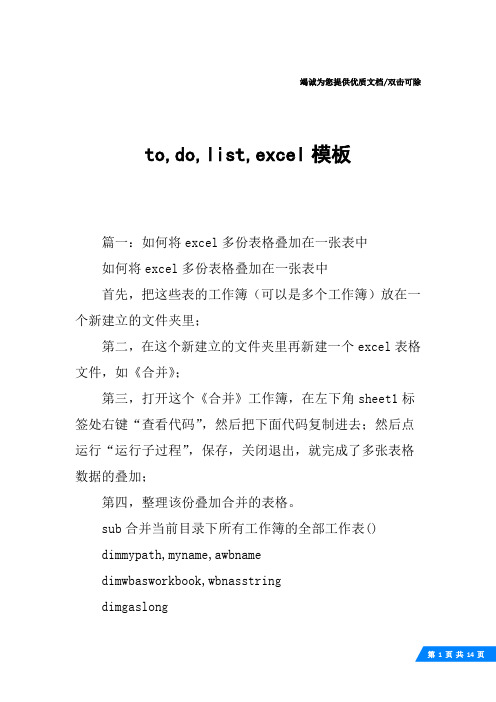
竭诚为您提供优质文档/双击可除to,do,list,excel模板篇一:如何将excel多份表格叠加在一张表中如何将excel多份表格叠加在一张表中首先,把这些表的工作簿(可以是多个工作簿)放在一个新建立的文件夹里;第二,在这个新建立的文件夹里再新建一个excel表格文件,如《合并》;第三,打开这个《合并》工作簿,在左下角sheet1标签处右键“查看代码”,然后把下面代码复制进去;然后点运行“运行子过程”,保存,关闭退出,就完成了多张表格数据的叠加;第四,整理该份叠加合并的表格。
sub合并当前目录下所有工作簿的全部工作表()dimmypath,myname,awbnamedimwbasworkbook,wbnasstringdimgaslongdimnumaslongdimboxasstringapplication.screenupdating=Falsemypath=activeworkbook.pathmyname=dir(mypath//是否对header进行冻结,让表头随着滚动条而滚动。
默认:falsesetheader(string[])方法是添加要显示的内容的标题的,就好比是table标题(thead).最后调用write(list,"F:/workspace/testFolder/workorder.xls") ;//第一个参数:数据集合(list servlet中则是:request.getsession().getservletcontext().getRealpat h("/")+"项目中的文件夹名字/workorder.xls";最后返回true和false,表示成功与否。
下面是代码部分packagecom.zhb.dbhelper;importjava.io.File;importjava.text.simpledateFormat;importjava.util.arraylist;importjava.util.date;importjava.util.list;importjxl.workbook;importjxl.format.underlinestyle;bel;importjxl.write.writablecellFormat;importjxl.write.writableFont;importjxl.write.writablesheet;importjxl.write.writableworkbook;importjxl.write.writeexception;/***传入各个属性并将数据写入excel*@author*通用报表格式*修改时间:20xx-07-11*修改内容:修改条件显示的格式,由原来的一行显示两个条件信息修改为一行显示一个条件信息,使报表看起来更直观,更简洁**/publicclassdoexcelhelper{privatestringtitle="报表";//标题privatestring[]header;//表头privatestring[]f_name;//条件名称privatestring[]f_value;//条件值privatebooleanisVerticalFreeze=false;//是否需要对行进行窗口冻结(默认不冻结)/***main方法*@paramargs*/listlist=newarraylist();list.add(newstring[]{"20xx-05-12","user1","user1登入了系统"});list.add(newstring[]{"20xx-05-13","user2","user 2登入了系统"});list.add(newstring[]{"20xx-05-14","user3","user 3登入了系统"});doexcelhelperdeh=newdoexcelhelper();deh.settitle("log日志");//添加报表标题string[]title={"操作时间","操作人员","操作内容"};deh.setheader(title);//添加报表的查询字段名称string[]fname={"开始时间","结束时间","操作用户"};deh.setF_name(fname);//没有查询字段则直接赋值null//添加报表的查询字段值string[]fvalue={"20xx-01-03","20xx-01-11","admin"," 20xx-05-06"};deh.setF_value(fvalue);//没有查询字段则直接赋值nulldeh.setisVerticalFreeze(true);//是否对header进行冻结,让表头随着滚动条而滚动。
list.tostring逆转方法__解释说明
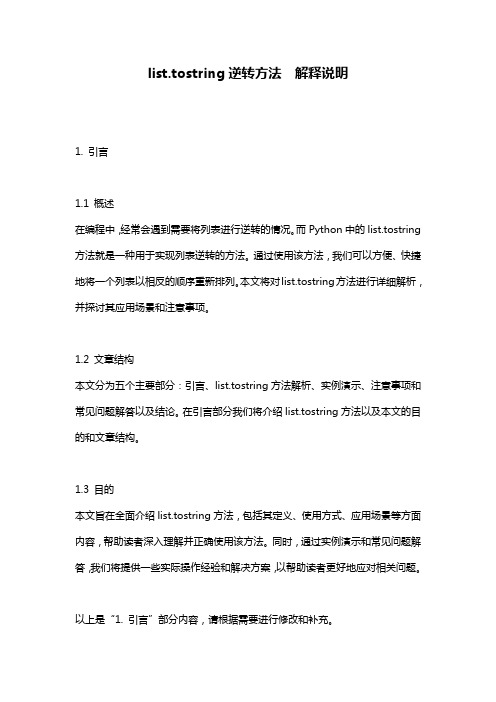
list.tostring逆转方法解释说明1. 引言1.1 概述在编程中,经常会遇到需要将列表进行逆转的情况。
而Python中的list.tostring 方法就是一种用于实现列表逆转的方法。
通过使用该方法,我们可以方便、快捷地将一个列表以相反的顺序重新排列。
本文将对list.tostring方法进行详细解析,并探讨其应用场景和注意事项。
1.2 文章结构本文分为五个主要部分:引言、list.tostring方法解析、实例演示、注意事项和常见问题解答以及结论。
在引言部分我们将介绍list.tostring方法以及本文的目的和文章结构。
1.3 目的本文旨在全面介绍list.tostring方法,包括其定义、使用方式、应用场景等方面内容,帮助读者深入理解并正确使用该方法。
同时,通过实例演示和常见问题解答,我们将提供一些实际操作经验和解决方案,以帮助读者更好地应对相关问题。
以上是“1. 引言”部分内容,请根据需要进行修改和补充。
2. list.tostring方法解析2.1 list.tostring方法的定义list.tostring方法是一个用于将列表转换为字符串表示形式的函数。
它接受一个列表参数,并返回一个字符串,其中包含了列表中的元素。
2.2 使用list.tostring方法逆转列表使用list.tostring方法可以方便地逆转一个列表。
具体步骤如下:1. 将需要逆转的列表作为参数传入list.tostring方法。
2. 方法会遍历列表中的元素,并按照原来顺序将它们连接起来,形成一个新的字符串。
3. 返回的字符串即为将原始列表中的元素逆序排列后得到的结果。
举个例子,假设我们有一个列表[1, 2, 3, 4, 5],我们可以使用list.tostring方法来实现逆转:```pythonmy_list = [1, 2, 3, 4, 5]reversed_list = list.tostring(my_list)print(reversed_list)输出结果将会是:```[5, 4, 3, 2, 1]```通过调用list.tostring方法,我们成功地将原始列表中的元素逆序排列了。
python遍历list并删除部分元素

python遍历list并删除部分元素python 遍历list并删除部分元素https:///afgasdg/article/details/82844403有两个list,list_1 为0-9,list_2 为0-4,需要删除list_1中包含在list_2中的元素list_1 =[]for i in range(10):list_1.append(str(i))list_1['0', '1', '2', '3', '4', '5', '6', '7', '8', '9']list_2 =[]for i in range(5):list_2.append(str(i))list_2['0', '1', '2', '3', '4']为了提⾼执⾏效率,可以将⼤的list转成setset_2 = set(list_2)set_2{'0', '1', '2', '3', '4'}错误删除⽅式1直接遍历list并删除元素,这种⽅式会导致删除之后的元素前移,后漏掉⼀部分元素temp = list_1[:]for item in temp:if item in set_2:temp.remove(item)"列表长度:%d, 列表:%s" % (len(temp), temp)"列表长度:7, 列表:['1', '3', '5', '6', '7', '8', '9']"错误删除⽅式2使⽤下标遍历输出,删除元素,同样也会出现删除只有的元素前移导致漏掉部分元素temp = list_1[:]for i in range(len(temp)):try:if temp[i] in set_2:temp.pop(i)except:# 这⾥下标会越界,为了结果好看,不做处理pass"列表长度:%d, 列表:%s" % (len(temp), temp)"列表长度:7, 列表:['1', '3', '5', '6', '7', '8', '9']"正确⽅式1;倒序倒序(保证 next 指向为未遍历过得)列表长度减少,但是next指向⼀直是为未遍历过的元素,并不会漏掉temp = list_1[:]for i in range(len(temp)-1, -1, -1):if temp[i] in set_2:temp.pop(i)"列表长度:%d, 列表:%s" % (len(temp), temp)"列表长度:5, 列表:['5', '6', '7', '8', '9']"正确⽅式2;遍历复制数组,修改原数组这种⽅式能保证遍历到所有元素temp = list_1[:]for item in temp[:]:if item in set_2:temp.remove(item)"列表长度:%d, 列表:%s" % (len(temp), temp)"列表长度:5, 列表:['5', '6', '7', '8', '9']"正确⽅式3;遍历需要删除的数组temp = list_1[:]for item in set_2:try:temp.remove(item)except: # 这⾥元素不存在会抛异常pass"列表长度:%d, 列表:%s" % (len(temp), temp)"列表长度:5, 列表:['5', '6', '7', '8', '9']"正确⽅式4;利⽤集合差集,不能保证顺序temp = list_1[:]temp = list(set(temp).difference(set_2))"列表长度:%d, 列表:%s" % (len(temp), temp)"列表长度:5, 列表:['8', '9', '5', '7', '6']"---------------------作者:java爱好者来源:CSDN原⽂:https:///afgasdg/article/details/82844403 版权声明:本⽂为博主原创⽂章,转载请附上博⽂链接!。
青少年软件编程(Python)等级考试试卷(二级)2021
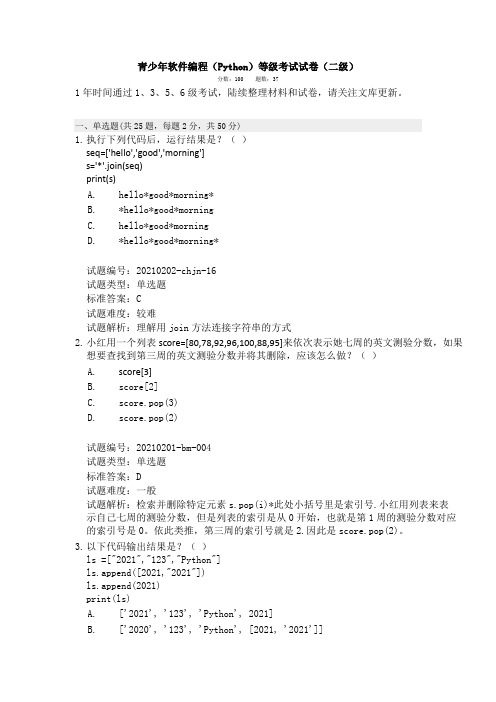
青少年软件编程(Python)等级考试试卷(二级)分数:100 题数:371年时间通过1、3、5、6级考试,陆续整理材料和试卷,请关注文库更新。
一、单选题(共25题,每题2分,共50分)1.执行下列代码后,运行结果是?()seq=['hello','good','morning']s='*'.join(seq)print(s)A. hello*good*morning*B. *hello*good*morningC. hello*good*morningD. *hello*good*morning*试题编号:20210202-chjn-16试题类型:单选题标准答案:C试题难度:较难试题解析:理解用join方法连接字符串的方式2.小红用一个列表score=[80,78,92,96,100,88,95]来依次表示她七周的英文测验分数,如果想要查找到第三周的英文测验分数并将其删除,应该怎么做?()A. score[3]B. score[2]C. score.pop(3)D. score.pop(2)试题编号:20210201-bm-004试题类型:单选题标准答案:D试题难度:一般试题解析:检索并删除特定元素s.pop(i)*此处小括号里是索引号.小红用列表来表示自己七周的测验分数,但是列表的索引是从0开始,也就是第1周的测验分数对应的索引号是0。
依此类推,第三周的索引号就是2.因此是score.pop(2)。
3.以下代码输出结果是?()ls =["2021","123","Python"]ls.append([2021,"2021"])ls.append(2021)print(ls)A. ['2021', '123', 'Python', 2021]B. ['2020', '123', 'Python', [2021, '2021']]C. ['2021', '123', 'Python', [2021, '2021'], 2021]D. ['2020', '123', 'Python', [2021],2021]试题编号:20210121-zy-05试题类型:单选题标准答案:C试题难度:一般试题解析:列表的添加4.已知Lista=list("five"),执行语句Lista[2:]=list("rst")后,列表Lista中的元素为?(A. ['f', 'i', 'v', 'e', 'r', 's', 't']B. ['f', 'r', 's', 't']C. ['f', 'i', 'r', 's']D. ['f', 'i', 'r', 's', 't']试题编号:20210215-fjn-6试题类型:单选题标准答案:D试题难度:较难试题解析:5.原有列表s=[5,2,9,1],下列哪个操作不能使得列表s变为[9,5,2,1]?()A. s.sort() s.reverse() print(s)B. s.sort(reverse=True) print(s)C. print(sorted(s,reverse=True))D. s.sort() print(s)试题编号:20210121-zy-08试题类型:单选题标准答案:D试题难度:一般试题解析:sort() 函数用于对原列表进行排序,reverse -- 排序规则,reverse = True 降序, reverse = False 升序(默认);sort 与 sorted 区别:sort 是应用在 list 上的方法,sorted 可以对所有可迭代的对象进行排序操作。
list.sort用法 java
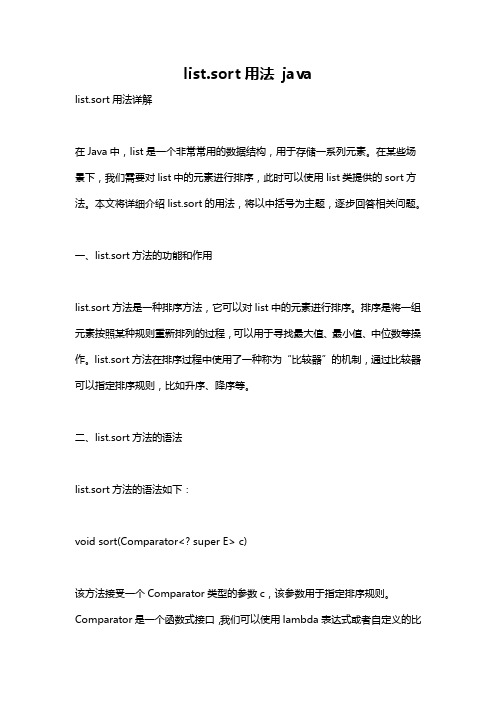
list.sort用法javalist.sort用法详解在Java中,list是一个非常常用的数据结构,用于存储一系列元素。
在某些场景下,我们需要对list中的元素进行排序,此时可以使用list类提供的sort方法。
本文将详细介绍list.sort的用法,将以中括号为主题,逐步回答相关问题。
一、list.sort方法的功能和作用list.sort方法是一种排序方法,它可以对list中的元素进行排序。
排序是将一组元素按照某种规则重新排列的过程,可以用于寻找最大值、最小值、中位数等操作。
list.sort方法在排序过程中使用了一种称为“比较器”的机制,通过比较器可以指定排序规则,比如升序、降序等。
二、list.sort方法的语法list.sort方法的语法如下:void sort(Comparator<? super E> c)该方法接受一个Comparator类型的参数c,该参数用于指定排序规则。
Comparator是一个函数式接口,我们可以使用lambda表达式或者自定义的比较器来创建一个Comparator对象。
三、使用默认排序规则进行排序如果list中的元素已经实现了Comparable接口,那么list.sort方法将会使用该接口的compareT o方法进行排序。
该方法在排序过程中会比较两个对象的大小,根据正负返回不同的结果。
下面是排序一个整型list的示例代码:List<Integer> list = new ArrayList<>();list.add(5);list.add(3);list.add(7);list.sort(null);System.out.println(list);输出结果为:[3, 5, 7]。
可以看到,list中的元素按照升序重新排列。
四、使用自定义排序规则进行排序如果list中的元素没有实现Comparable接口,或者我们需要使用其他的排序规则,我们可以创建一个Comparator对象来指定排序规则。
intialization_list的典型用途_概述及解释说明

intialization list的典型用途概述及解释说明1. 引言1.1 概述在C++编程中,初始化列表(initialization list)是一种特殊的语法结构,用于在对象的构造函数中初始化成员变量。
它允许我们在创建对象时直接为成员变量赋初值,而不需要通过赋值操作符或构造函数体内的赋值语句来完成初始化。
使用初始化列表可以提高代码性能和效率,并且支持更复杂的对象初始化和构造过程。
在本文中,我们将概述和解释intialization list的典型用途。
1.2 文章结构本文主要分为以下几个部分:引言:对文章进行介绍,并说明文章结构和目的。
intialization list的概念解释及用途介绍:对intialization list进行定义解释,并介绍其语法和使用方法。
探讨其在不同数据类型中的典型应用场景。
intialization list的优点和作用:详细说明使用intialization list所带来的优点和作用。
包括提高代码性能和效率、避免不必要的拷贝和转换操作以及支持更复杂的对象初始化和构造过程。
使用intialization list的注意事项和技巧:列举并详细解释使用intialization list时需要注意的事项和一些技巧。
包括初始值顺序与类成员声明顺序一致性问题、多参数、多继承等特殊情况下的使用注意事项,以及针对不同编译器和标准的兼容性问题及解决方案。
结论:对本文内容进行总结,并展望使用intialization list的未来发展方向。
1.3 目的本文旨在全面介绍intialization list在C++编程中的典型用途。
通过详细的概念解释和示例代码,帮助读者更好地理解和掌握intialization list的语法和用法。
同时,还将深入探讨使用intialization list所带来的优点和作用,并提供实际应用中需要注意的事项和技巧。
通过阅读本文,读者可以更加灵活地应用intialization list来提高代码可读性和性能。
centos ln -s用法

在CentOS 或其他类Unix 系统中,ln -s命令用于创建符号链接(也称为软链接)。
符号链接是一个特殊的文件,它指向另一个文件或目录的路径。
基本语法如下:
bash复制代码
ln -s [目标文件或目录] [链接名]
•[目标文件或目录]:这是你希望链接指向的文件或目录的路径。
•[链接名]:这是你希望创建的链接的名称。
例如,如果你有一个名为original.txt的文件,并希望创建一个名为link_to_original.txt的链接,你可以使用以下命令:
bash复制代码
ln -s original.txt link_to_original.txt
现在,link_to_original.txt将作为original.txt的符号链接存在。
你可以通过ls -l查看链接的详细信息,其中l代表长格式,它将显示文件或目录的详细属性,包括符号链接。
注意:如果目标文件或目录移动、重命名或删除,符号链接将变得无效。
listoperations range用法
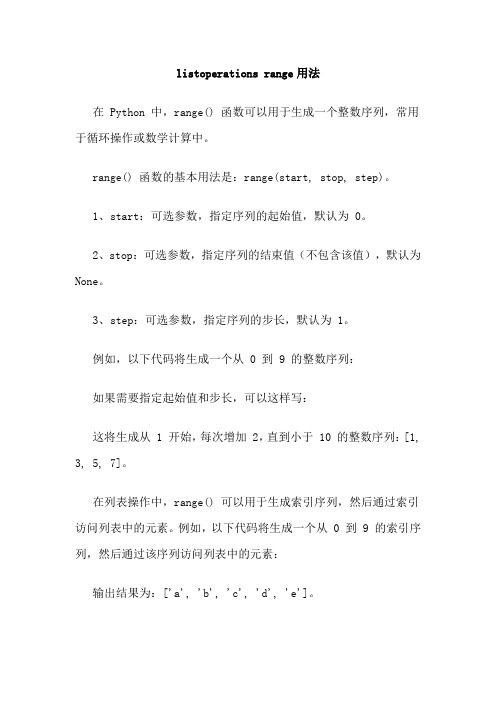
listoperations range用法
在 Python 中,range() 函数可以用于生成一个整数序列,常用于循环操作或数学计算中。
range() 函数的基本用法是:range(start, stop, step)。
1、start:可选参数,指定序列的起始值,默认为 0。
2、stop:可选参数,指定序列的结束值(不包含该值),默认为None。
3、step:可选参数,指定序列的步长,默认为 1。
例如,以下代码将生成一个从 0 到 9 的整数序列:
如果需要指定起始值和步长,可以这样写:
这将生成从 1 开始,每次增加 2,直到小于 10 的整数序列:[1, 3, 5, 7]。
在列表操作中,range() 可以用于生成索引序列,然后通过索引访问列表中的元素。
例如,以下代码将生成一个从 0 到 9 的索引序列,然后通过该序列访问列表中的元素:
输出结果为:['a', 'b', 'c', 'd', 'e']。
C#中List用法介绍详解
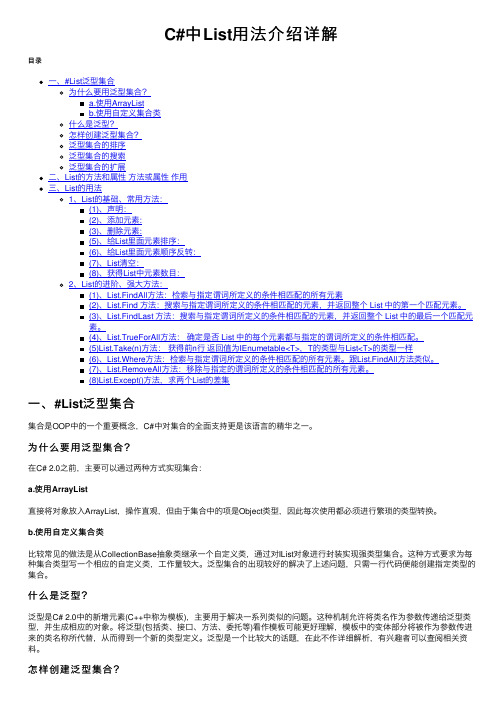
C#中List⽤法介绍详解⽬录⼀、#List泛型集合为什么要⽤泛型集合?a.使⽤ArrayListb.使⽤⾃定义集合类什么是泛型?怎样创建泛型集合?泛型集合的排序泛型集合的搜索泛型集合的扩展⼆、List的⽅法和属性⽅法或属性作⽤三、List的⽤法1、List的基础、常⽤⽅法:(1)、声明:(2)、添加元素:(3)、删除元素:(5)、给List⾥⾯元素排序:(6)、给List⾥⾯元素顺序反转:(7)、List清空:(8)、获得List中元素数⽬:2、List的进阶、强⼤⽅法:(1)、List.FindAll⽅法:检索与指定谓词所定义的条件相匹配的所有元素(2)、List.Find ⽅法:搜索与指定谓词所定义的条件相匹配的元素,并返回整个 List 中的第⼀个匹配元素。
(3)、List.FindLast ⽅法:搜索与指定谓词所定义的条件相匹配的元素,并返回整个 List 中的最后⼀个匹配元素。
(4)、List.TrueForAll⽅法:确定是否 List 中的每个元素都与指定的谓词所定义的条件相匹配。
(5)List.Take(n)⽅法:获得前n⾏返回值为IEnumetable<T>,T的类型与List<T>的类型⼀样(6)、List.Where⽅法:检索与指定谓词所定义的条件相匹配的所有元素。
跟List.FindAll⽅法类似。
(7)、List.RemoveAll⽅法:移除与指定的谓词所定义的条件相匹配的所有元素。
(8)List.Except()⽅法,求两个List的差集⼀、#List泛型集合集合是OOP中的⼀个重要概念,C#中对集合的全⾯⽀持更是该语⾔的精华之⼀。
为什么要⽤泛型集合?在C# 2.0之前,主要可以通过两种⽅式实现集合:a.使⽤ArrayList直接将对象放⼊ArrayList,操作直观,但由于集合中的项是Object类型,因此每次使⽤都必须进⾏繁琐的类型转换。
